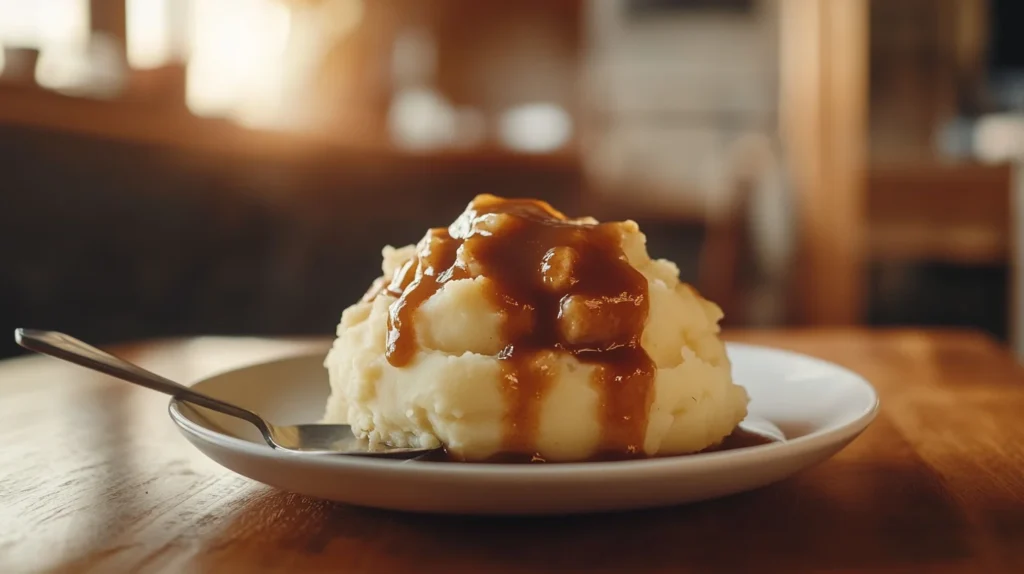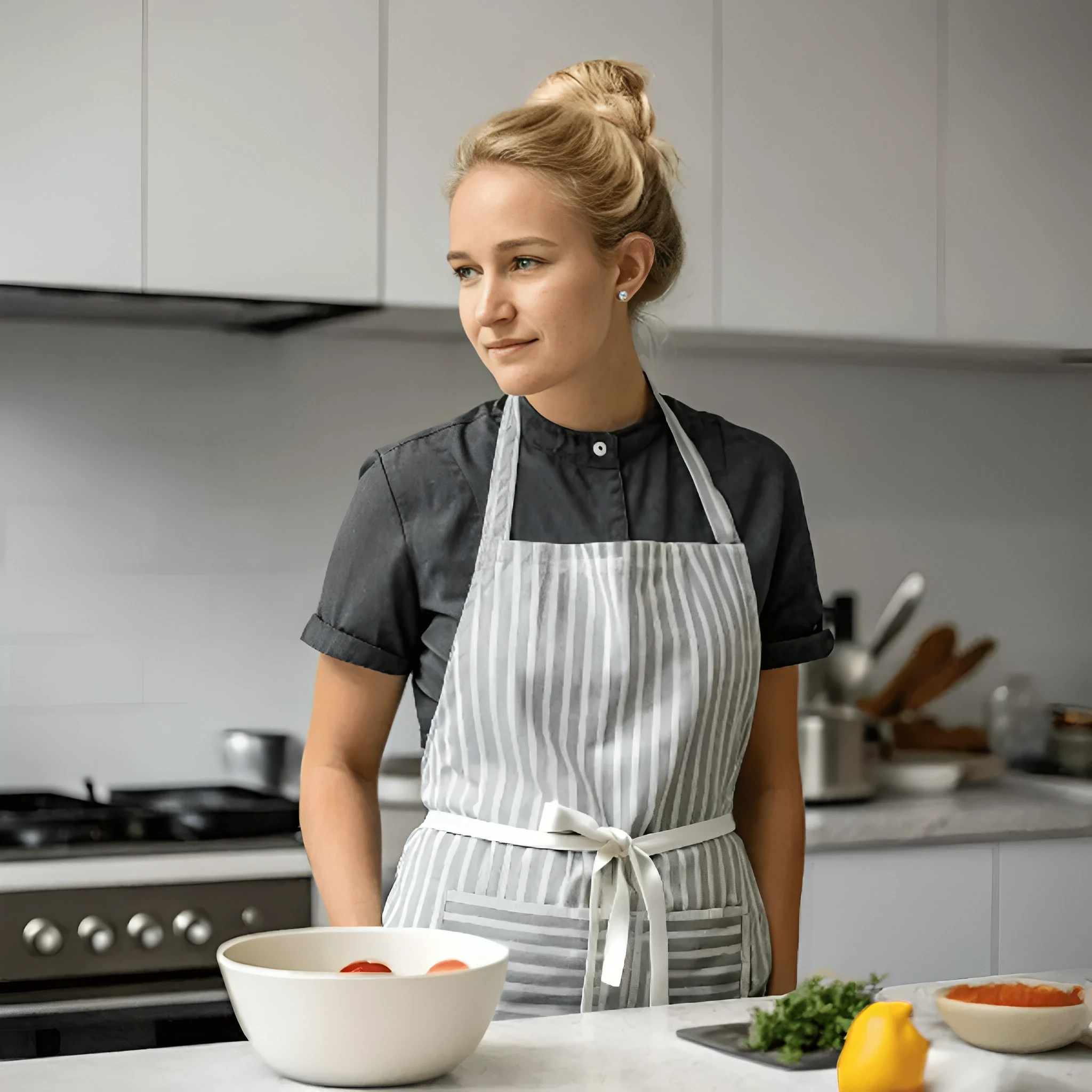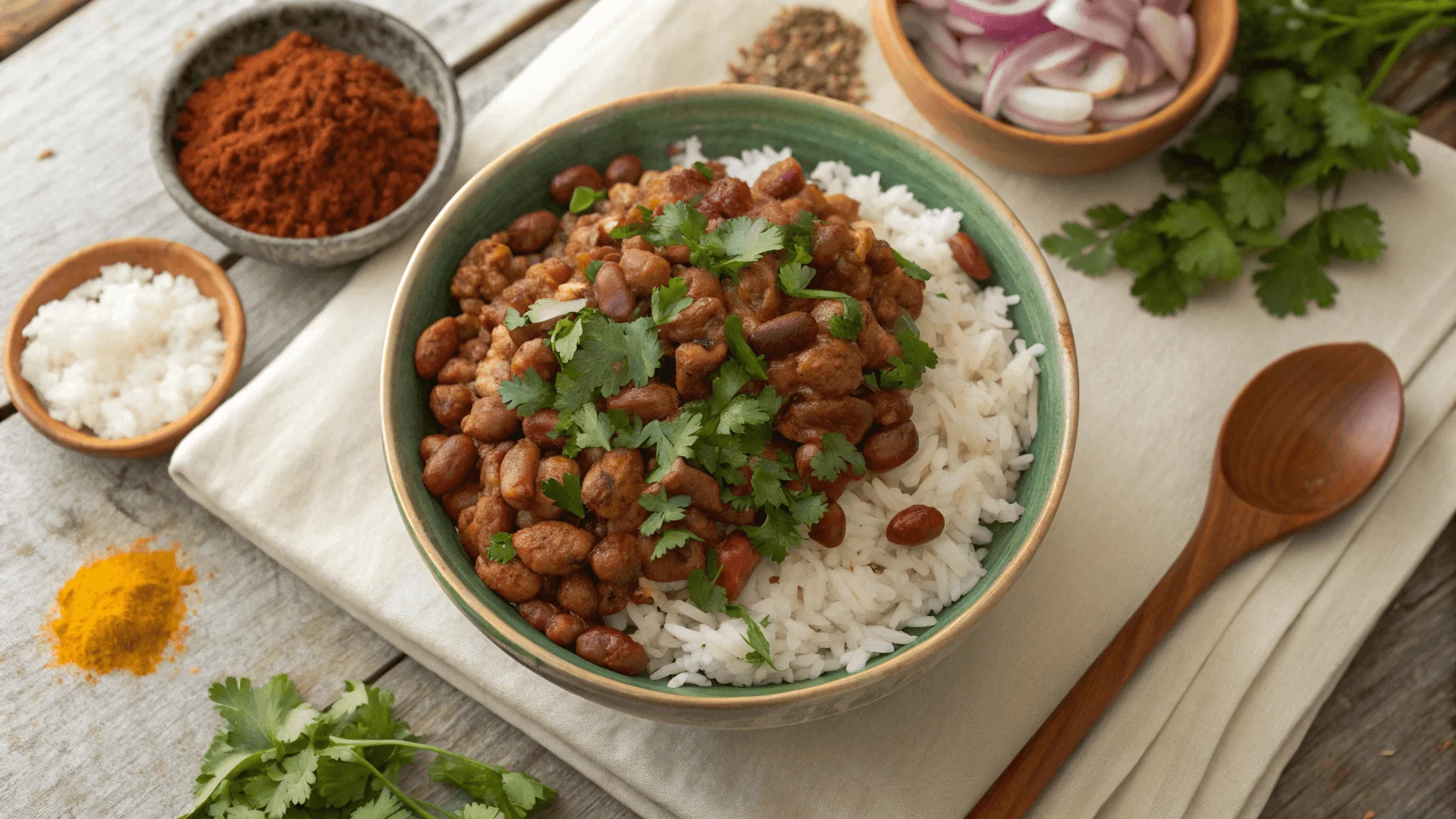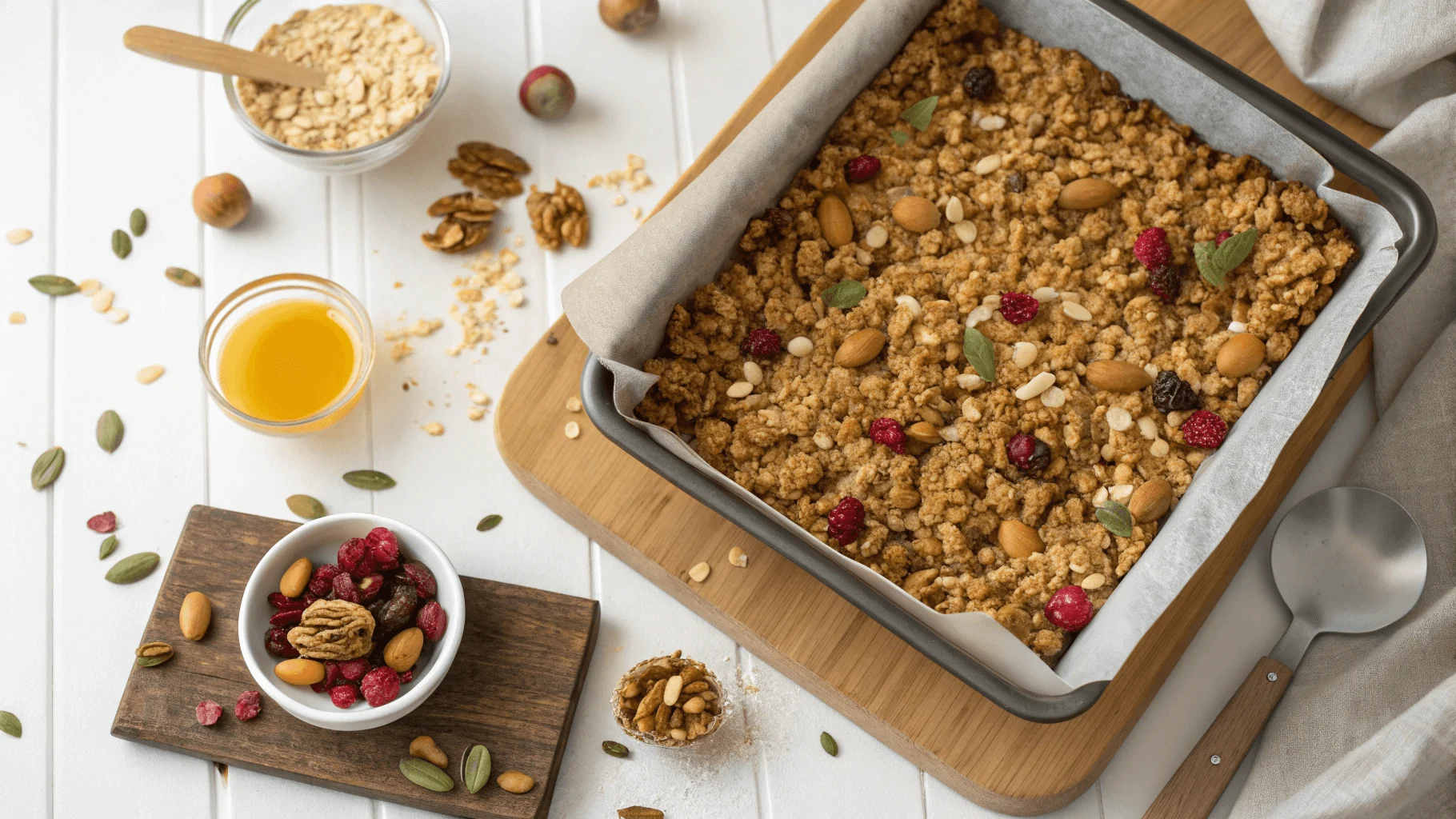Mashed potatoes with gravy is a comforting, classic dish that has earned its place at the table for many family gatherings, holidays, and everyday meals. The rich and creamy mashed potatoes often pair with a flavorful gravy that adds depth and moisture to the dish. But what does mashed potatoes gravy contain? The answer varies depending on the recipe, but traditionally, mashed potatoes gravy uses simple ingredients like butter, flour, stock, and seasonings. The gravy serves as the perfect topping to the creamy potatoes, enhancing the overall taste and texture.
In this article, we’ll break down everything you need to know about mashed potatoes gravy, from the ingredients used to how to make it. Whether you’re making a classic version or a creative twist, understanding the foundation of mashed potatoes gravy is essential for mastering this beloved dish. Let’s dive into the details.
Ingredients Used in Mashed Potatoes Gravy
When answering the question, “What is mashed potatoes gravy made of?” it’s important to note that the ingredients vary depending on the type of gravy you make. However, several core ingredients commonly appear in mashed potatoes gravy:
- Butter: Adds richness and a smooth texture to the gravy.
- Flour: Used as a thickening agent to give the gravy its desired consistency.
- Stock or Broth: Whether chicken, beef, or vegetable stock, this ingredient provides the primary flavor base for the gravy.
- Seasonings: Salt, pepper, and herbs such as thyme or rosemary are often added to enhance the taste.
- Milk or Cream: These ingredients add creaminess to the gravy, making it velvety and smooth.
Depending on the recipe, you can add additional ingredients like garlic, onion, or even wine for extra flavor. The key to a good mashed potatoes gravy is balancing these ingredients to create a smooth, flavorful sauce that complements the mashed potatoes perfectly.
How to Make Classic Mashed Potatoes Gravy
Now that we know the basic ingredients, let’s dive into how to make classic mashed potatoes gravy. The process begins by preparing the gravy base, which starts with making a roux (a mixture of flour and fat). Here’s a simple method for making mashed potatoes gravy:
- Melt Butter: In a saucepan, melt butter over medium heat.
- Add Flour: Stir in the flour and cook for about a minute, forming a smooth paste.
- Add Stock: Gradually whisk in your stock (beef, chicken, or vegetable), ensuring there are no lumps.
- Simmer: Let the mixture simmer for a few minutes to thicken.
- Add Seasonings: Season with salt, pepper, and any herbs you prefer.
- Finish with Cream: For a smoother, creamier texture, add milk or heavy cream.
Once the gravy has reached your desired consistency, pour it over your mashed potatoes for the perfect combination of creamy and savory.
For those looking for inspiration, this guide to mashed potatoes with gravy offers a detailed walkthrough of classic recipes and tips for perfecting your technique.
Variations of Mashed Potatoes Gravy
There are several variations of mashed potatoes gravy, each offering unique flavors and textures. If you’re wondering what mashed potatoes gravy is made of, different recipes may include different ingredients or techniques. Here are a few popular variations:
- Brown Gravy: Made with beef stock and a darker roux, brown gravy has a rich, savory flavor.
- Turkey Gravy: Often made with turkey drippings and stock, this gravy is perfect for Thanksgiving dinners.
- Vegetarian Gravy: A vegetarian version can be made using vegetable stock and plant-based butter, making it suitable for those who avoid animal products.
- Mushroom Gravy: With the addition of sautéed mushrooms, this gravy offers a deliciously earthy flavor.
For more creative twists on this classic dish, explore the ultimate guide to mashed potatoes and gravy. Experimenting with different variations can help you find your perfect mashed potatoes gravy recipe.
Serving Mashed Potatoes with Gravy
When serving mashed potatoes with gravy, the key is to apply the right amount of gravy for the perfect balance of flavors. Pour the gravy generously over the mashed potatoes, but don’t overdo it to ensure the mashed potatoes retain their creamy texture. You can also serve the gravy on the side for guests to add to their liking.
It’s important to serve the mashed potatoes and gravy immediately after making them to ensure they stay hot and fresh. You can also garnish the dish with fresh herbs like parsley for a pop of color and added flavor.
If you’re wondering about the best side dishes or meal combinations, this guide to pairing mashed potatoes with meals can offer great inspiration.
History of Mashed Potatoes Gravy
Mashed potatoes and gravy have a long history, dating back centuries to when potatoes were first introduced to Europe from South America. Over time, mashed potatoes became a staple in many cultures due to their versatility and ability to pair well with a wide variety of meats.
Gravy, on the other hand, has served for centuries to make use of meat drippings and create flavorful sauces to accompany meals. People likely popularized the combination of mashed potatoes and gravy in the United States during the 19th century, when they widely cultivated and easily accessed potatoes.
Today, people consider mashed potatoes with gravy a quintessential comfort food enjoyed across the globe, especially during holidays and special occasions.
Cultural Significance of Mashed Potatoes and Gravy
Mashed potatoes and gravy hold a special place in many cultures, particularly in Western cuisines. In the United States, mashed potatoes with gravy are commonly served during Thanksgiving dinners, alongside turkey and other traditional dishes. This dish is often associated with family gatherings and celebrations.
In the United Kingdom, people serve mashed potatoes with a variety of meat dishes and often pair them with rich, savory gravies made from meat drippings. In other parts of the world, such as Scandinavia, people serve mashed potatoes with lingonberry jam and rich gravies made from roast meats.
Overall, mashed potatoes with gravy are more than just a dish—they represent tradition, comfort, and togetherness in many cultures.
Nutritional Value of Mashed Potatoes Gravy
When considering the question, “What is mashed potatoes gravy made of?” it’s also important to think about its nutritional content. The calorie count and nutritional value of mashed potatoes gravy depend largely on the ingredients used. Traditional mashed potatoes with gravy can be high in fat and calories, particularly if butter, cream, or meat-based stock is included.
Here’s a breakdown of the general nutritional profile:
- Mashed Potatoes: A serving of mashed potatoes typically contains around 150 calories, with the majority of calories coming from carbohydrates. If made with butter and cream, the calorie count will be higher.
- Gravy: A typical serving of gravy can add about 30-50 calories, depending on how much fat or cream is used.
If you’re looking to reduce the calorie content, you can make healthier substitutions, such as using low-fat milk or vegetable broth instead of heavy cream or meat-based stock.
How to Make Gluten-Free Mashed Potatoes Gravy
For those who have dietary restrictions or prefer gluten-free options, it’s easy to make mashed potatoes gravy without gluten. The key is to substitute flour with a gluten-free thickening agent. Here’s how to make gluten-free mashed potatoes gravy:
- Use Gluten-Free Flour or Cornstarch: Instead of regular flour, use gluten-free flour, rice flour, or cornstarch to make the roux.
- Cook the Roux: Cook the gluten-free flour in melted butter just like you would regular flour, ensuring the mixture thickens properly.
- Add Stock: Gradually whisk in your preferred stock (vegetable or chicken) until the gravy reaches your desired consistency.
- Season to Taste: Add salt, pepper, and herbs to taste.
This gluten-free version of mashed potatoes gravy will be just as rich and flavorful as the classic version, without the gluten.
The Secret to Smooth and Lump-Free Gravy
The secret to lump-free mashed potatoes gravy lies in the technique you use when adding stock to the roux. To avoid lumps:
- Add Liquid Gradually: Always add the stock or broth slowly while whisking continuously.
- Use a Whisk: A whisk is the best tool to break up any lumps as you stir the gravy.
- Strain the Gravy: If lumps do appear, simply strain the gravy through a fine mesh sieve before serving.
These simple steps will ensure your mashed potatoes gravy is smooth and lump-free every time.
How to Adjust Gravy for Different Potatoes Varieties
Different types of potatoes can affect the texture and consistency of mashed potatoes and, by extension, the gravy. For example, waxy potatoes like red potatoes or Yukon Golds create a creamier mashed potato, which may require less gravy to achieve the perfect balance. On the other hand, starchy potatoes like Russets create fluffier mashed potatoes, which may absorb more gravy.
Here are some tips for adjusting gravy based on the type of potato:
- Waxy Potatoes: Use a slightly thicker gravy for waxy potatoes to avoid overwhelming the dish with too much liquid.
- Starchy Potatoes: A thinner gravy works best with starchy potatoes, allowing it to soak into the fluffy mashed potatoes.
Pairing Mashed Potatoes Gravy with Different Side Dishes
Mashed potatoes with gravy can be paired with a variety of side dishes, making it a versatile option for many meals. Here are some popular pairings:
- Roast Meats: Mashed potatoes and gravy pair perfectly with roast beef, turkey, or chicken.
- Vegetables: Green beans, peas, and carrots complement mashed potatoes and gravy with their fresh, vibrant flavors.
- Bread: A warm roll or biscuit can help soak up the extra gravy, creating a satisfying meal.
When considering side dishes, it’s important to balance flavors and textures to create a well-rounded plate.
The Science Behind Gravy: Why It Thickens
When making mashed potatoes gravy, understanding the science behind why it thickens can help you achieve the perfect consistency. The primary reason gravy thickens is the interaction between starch (from the flour or cornstarch) and liquid. When the starch comes into contact with heat and liquid, it absorbs the liquid and swells, creating a thicker mixture.
The key to getting the right consistency is ensuring that the gravy is cooked long enough for the starch to fully absorb the liquid and thicken. If the gravy is too thin, let it simmer longer. If it’s too thick, add more liquid.
Using Leftover Mashed Potatoes for Gravy
If you have leftover mashed potatoes, you can easily incorporate them into your gravy to create a creamy, thickened sauce. Simply add the mashed potatoes to the gravy and stir until fully incorporated. This will create a rich and velvety gravy that’s perfect for serving with additional mashed potatoes or other dishes.
How to Make Gravy Without Stock
Sometimes, you may not have stock on hand, but you can still make a flavorful gravy using just a few simple ingredients. Here’s how:
- Use Water: If you don’t have stock, you can use water as the base for your gravy.
- Add Seasonings: To make up for the lack of flavor in water, use extra seasonings such as herbs, garlic, and onion.
- Use Drippings: If you’ve roasted meat, use the drippings left in the pan to add flavor to your gravy.
With the right seasonings and techniques, you can make a flavorful gravy even without stock.
How to Make Gravy with a Slow Cooker
Making gravy in a slow cooker is an easy way to prepare this dish while keeping the kitchen clean. Here’s how to make mashed potatoes gravy in a slow cooker:
- Start with a Roux: In a separate pan, prepare the roux by melting butter and stirring in flour.
- Add Stock: Pour in your stock gradually while stirring until the gravy thickens.
- Transfer to Slow Cooker: Once the gravy has thickened, transfer it to the slow cooker and let it cook on low for 2-3 hours.
This method is perfect for making large batches of gravy without constant supervision.
Best Cooking Methods for Mashed Potatoes and Gravy
The best cooking methods for mashed potatoes and gravy involve careful attention to detail. For mashed potatoes, ensure you’re using the right type of potato for the texture you desire, and cook them thoroughly before mashing. For the gravy, ensure that you’re using a slow and steady approach to avoid burning or curdling the sauce.
FAQs
- Can I make mashed potatoes gravy ahead of time?
Yes, you can make mashed potatoes gravy ahead of time and store it in the refrigerator. Simply reheat it on the stove before serving. - Can I use cornstarch instead of flour for gravy?
Yes, cornstarch can be used as a thickening agent in place of flour for a gluten-free gravy.
Conclusion
In conclusion, mashed potatoes gravy is made from a combination of simple ingredients like butter, flour, stock, and seasonings. Whether you’re making a classic version or a creative variation, the key is to balance the flavors and textures to complement the creamy mashed potatoes. Understanding the ingredients and techniques behind mashed potatoes gravy can help you create a perfect dish every time.






4 thoughts on “Mashed Potatoes Gravy Ingredients: What is It Made Of?”